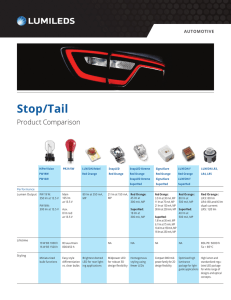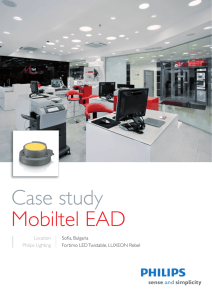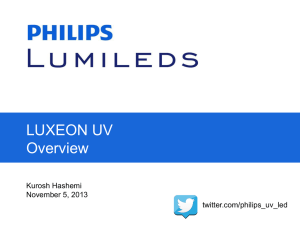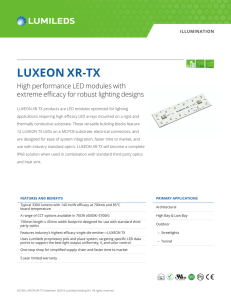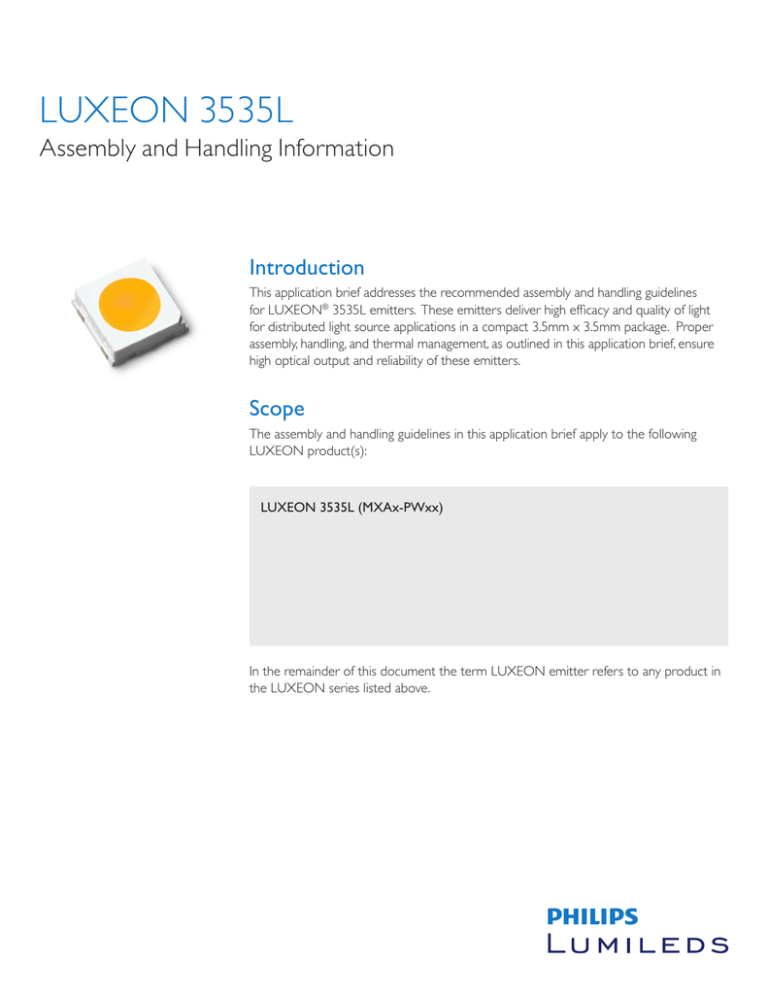
LUXEON 3535L
Assembly and Handling Information
Introduction
This application brief addresses the recommended assembly and handling guidelines
for LUXEON® 3535L emitters. These emitters deliver high efficacy and quality of light
for distributed light source applications in a compact 3.5mm x 3.5mm package. Proper
assembly, handling, and thermal management, as outlined in this application brief, ensure
high optical output and reliability of these emitters.
Scope
The assembly and handling guidelines in this application brief apply to the following
LUXEON product(s):
LUXEON 3535L (MXAx-PWxx)
In the remainder of this document the term LUXEON emitter refers to any product in
the LUXEON series listed above.
Table of Contents
Introduction . . . . . . . . . . . . . . . . . . . . . . . . . . . . . . . . . . . . . . . . . . . . . . . . . . . . . . . . . . . . . . . . . . . . . . . . . . . . . . . . . . . . . . . . . . . . . 1
Scope . . . . . . . . . . . . . . . . . . . . . . . . . . . . . . . . . . . . . . . . . . . . . . . . . . . . . . . . . . . . . . . . . . . . . . . . . . . . . . . . . . . . . . . . . . . . . . . . . . . 1
1. Component . . . . . . . . . . . . . . . . . . . . . . . . . . . . . . . . . . . . . . . . . . . . . . . . . . . . . . . . . . . . . . . . . . . . . . . . . . . . . . . . . . . . . . . . . . . 3
1.1 Description . . . . . . . . . . . . . . . . . . . . . . . . . . . . . . . . . . . . . . . . . . . . . . . . . . . . . . . . . . . . . . . . . . . . . . . . . . . . . . . . . . . . . . 3
1.2 Optical Center . . . . . . . . . . . . . . . . . . . . . . . . . . . . . . . . . . . . . . . . . . . . . . . . . . . . . . . . . . . . . . . . . . . . . . . . . . . . . . . . . . . . 3
1.3 Handling Precautions . . . . . . . . . . . . . . . . . . . . . . . . . . . . . . . . . . . . . . . . . . . . . . . . . . . . . . . . . . . . . . . . . . . . . . . . . . . . . . . 3
1.4 Cleaning . . . . . . . . . . . . . . . . . . . . . . . . . . . . . . . . . . . . . . . . . . . . . . . . . . . . . . . . . . . . . . . . . . . . . . . . . . . . . . . . . . . . . . . . . . 3
1.5 Electrical Isolation . . . . . . . . . . . . . . . . . . . . . . . . . . . . . . . . . . . . . . . . . . . . . . . . . . . . . . . . . . . . . . . . . . . . . . . . . . . . . . . . . . 3
1.6 Mechanical Files . . . . . . . . . . . . . . . . . . . . . . . . . . . . . . . . . . . . . . . . . . . . . . . . . . . . . . . . . . . . . . . . . . . . . . . . . . . . . . . . . . . 4
2. PCB Design Guidelines for the LUXEON Emitter . . . . . . . . . . . . . . . . . . . . . . . . . . . . . . . . . . . . . . . . . . . . . . . . . . . . . . . . . . . . 4
2.1 PCB Footprint and Land Pattern . . . . . . . . . . . . . . . . . . . . . . . . . . . . . . . . . . . . . . . . . . . . . . . . . . . . . . . . . . . . . . . . . . . . . 4
2.2 Surface Finishing . . . . . . . . . . . . . . . . . . . . . . . . . . . . . . . . . . . . . . . . . . . . . . . . . . . . . . . . . . . . . . . . . . . . . . . . . . . . . . . . . . . 4
2.3 Minimum Spacing . . . . . . . . . . . . . . . . . . . . . . . . . . . . . . . . . . . . . . . . . . . . . . . . . . . . . . . . . . . . . . . . . . . . . . . . . . . . . . . . . . 4
3. Thermal Management . . . . . . . . . . . . . . . . . . . . . . . . . . . . . . . . . . . . . . . . . . . . . . . . . . . . . . . . . . . . . . . . . . . . . . . . . . . . . . . . . . . 5
4. Thermal Measurement Guidelines . . . . . . . . . . . . . . . . . . . . . . . . . . . . . . . . . . . . . . . . . . . . . . . . . . . . . . . . . . . . . . . . . . . . . . . . . 6
5. Assembly Process Guidelines . . . . . . . . . . . . . . . . . . . . . . . . . . . . . . . . . . . . . . . . . . . . . . . . . . . . . . . . . . . . . . . . . . . . . . . . . . . . . 6
5.1 Stencil Design . . . . . . . . . . . . . . . . . . . . . . . . . . . . . . . . . . . . . . . . . . . . . . . . . . . . . . . . . . . . . . . . . . . . . . . . . . . . . . . . . . . . . 6
5.2 Solder Paste . . . . . . . . . . . . . . . . . . . . . . . . . . . . . . . . . . . . . . . . . . . . . . . . . . . . . . . . . . . . . . . . . . . . . . . . . . . . . . . . . . . . . . 6
5.3 Solder Reflow Profile . . . . . . . . . . . . . . . . . . . . . . . . . . . . . . . . . . . . . . . . . . . . . . . . . . . . . . . . . . . . . . . . . . . . . . . . . . . . . . . 6
5.4 Pick and Place . . . . . . . . . . . . . . . . . . . . . . . . . . . . . . . . . . . . . . . . . . . . . . . . . . . . . . . . . . . . . . . . . . . . . . . . . . . . . . . . . . . . . 7
5.5 Electrostatic Discharge Protection . . . . . . . . . . . . . . . . . . . . . . . . . . . . . . . . . . . . . . . . . . . . . . . . . . . . . . . . . . . . . . . . . . . . 7
6. Packaging Considerations – Chemical Compatibility . . . . . . . . . . . . . . . . . . . . . . . . . . . . . . . . . . . . . . . . . . . . . . . . . . . . . . . . . . 7
LUXEON 3535L Assembly and Handling Information AB203 20130306 ©2013 Philips Lumileds Lighting Company. 2
1.Component
1.1Description
The LUXEON 3535L emitter (Figure 1) consists of a 3535 lead-frame package with an anode and a cathode. A small
notch on the corner of the package marks the cathode side of the emitter package. The anode and cathode both serve
as thermal pads for the emitter, with the majority of the heat being dissipated through the larger pad, corresponding to
the cathode. The LUXEON emitter does not include any transient voltage suppressor (TVS) chip to protect the emitter
against electrostatic discharges (ESD) Appropriate precautions should therefore be taken when handling this device (see
Section 5.5).
1.2
Optical Center
The optical center coincides with the mechanical center of the LUXEON emitter. Optical rayset data for the LUXEON
emitter are available on the Philips Lumileds website at www.philipslumileds.com.
1.3
Handling Precautions
The LUXEON emitter is designed to maximize light output and reliability. However, improper handling of the device may
damage the silicone coating and affect the overall performance and reliability. In order to minimize the risk of damage to
the silicone coating during handling, the LUXEON emitter should only be picked up from the side of the package.
1.4Cleaning
The LUXEON emitter should not be exposed to dust and debris. Excessive dust and debris may cause a drastic decrease
in optical output. In the event that a LUXEON emitter requires cleaning, first try a gentle swabbing using a lint-free swab.
If needed, a lint-free swab and isopropyl alcohol (IPA) can be used to gently remove dirt from the silicone coating. Do not
use other solvents as they may adversely react with the package of the LUXEON emitter. For more information regarding
chemical compatibility, see Section 6.
1.5
Electrical Isolation
The LUXEON emitter has two electrodes, with a nominal spacing of 0.65mm, at the bottom of the package. In addition,
the LUXEON emitter contains two tabs on the side of the package. These tabs are cut-off remnants of the lead-frame and
are electrically connected to the anode and cathode, respectively. So it is important to keep sufficient distance between
the LUXEON emitter package and any other objects or neighboring LUXEON emitters to prevent any accidental shorts.
In order to avoid any electrical shocks and/or damage to the LUXEON emitter, each design needs to comply with the
appropriate standards of safety and isolation distances, known as clearance and creepage distances, respectively (e.g.
IEC60950, clause 2.10.4).
Figure 1. Package rendering of the LUXEON 3535L emitter.
LUXEON 3535L Assembly and Handling Information AB203 20130306 ©2013 Philips Lumileds Lighting Company. 3
Figure 2. Recommended PCB footprint design for the LUXEON emitter. In order to ensure
proper heat dissipation from the package electrodes to the PCB, it is best to extend the top copper layer
of the PCB several millimeters beyond the package of the LUXEON emitter. All dimensions are in mm.
1.6
Mechanical Files
Mechanical drawings for the LUXEON emitter are available on the Philips Lumileds website at www.philipslumileds.com.
2.PCB Design Guidelines for the LUXEON Emitter
The LUXEON emitter is designed to be soldered onto a Printed Circuit Board (PCB). To ensure optimal operation, the
PCB should be designed to minimize the overall thermal resistance between the LED package and the heat sink.
2.1
PCB Footprint and Land Pattern
The recommended PCB footprint design for the LUXEON emitter is shown in Figure 2. In order to ensure proper heat
dissipation from the emitter electrodes to the PCB, it is best to extend the top copper layer of the PCB beyond the
perimeter of the LUXEON emitter by 3mm – 4mm (see Section 3).
2.2
Surface Finishing
Philips Lumileds recommends using a high temperature organic solderability preservative (OSP) on the copper layer.
2.3
Minimum Spacing
Philips Lumileds recommends a minimum edge to edge spacing between LUXEON emitters of 0.5mm. Placing multiple
LUXEON emitters too close to each other may adversely impact the ability of the PCB to dissipate the heat from the
emitters and may cause accidental shorts between the metal stubs on the side of neighboring LUXEON emitters.
LUXEON 3535L Assembly and Handling Information AB203 20130306 ©2013 Philips Lumileds Lighting Company. 4
Figure 3. Maximum (left) and minimum (right) top side metallization on FR4 PCBs.
3.Thermal Management
The overall thermal resistance between a LUXEON emitter and the heat sink is strongly affected by the design and
material of the PCB on which the emitter is soldered. Metal Core PCBs have been historically used in the LED industry
for their low thermal resistance and rigidity. However, MCPCBs may not always offer the most economical solution. Multilayer epoxy FR4 PCBs are commonly used in the electronics industry and can, if properly designed, yield an appropriate
low-cost solution for various LED applications.
Philips Lumileds investigated the thermal performance of LUXEON emitters on a 1.0mm thick FR4 PCB with a top copper
plating of 35μm. In order to quantify the impact of the PCB metallization on the overall thermal resistance between
junction and heatsink, two different top side metallization configurations were considered (see Figure 3). Minimum top
side metallization corresponds to copper pads which did not extend beyond the outline of the LUXEON emitter package.
This configuration is representative for applications where multiple LEDs are placed in close proximity to each other.
Maximum top size metallization corresponds to copper pads which extend several millimeters beyond the outline of the
LUXEON emitter package. This situation is representative for distributed light applications where multiple LEDs are placed
relatively far apart. Table 1 summarizes the typical results from these thermal experiments. This table also includes typical
values for Ruj-s (see Section 4). Similar experiments with FR4 PCBs, which had full metallization at the bottom as well, did
not yield any noticeable improvements in Ruj-bottom PCB.
Table 1. Typical thermal resistance values for FR4 PCBs with minimum and maximum top side metallization.
Top Side Metallization
Typical Ruj- bottom PCB [K/W]
Typical Ruj-s [K/W]
Minimum
100
28
Maximum
58
32
LUXEON 3535L Assembly and Handling Information AB203 20130306 ©2013 Philips Lumileds Lighting Company. 5
Figure 4. The recommended temperature measurement point Ts is located right next to the cathode
of the LUXEON emitter on the PCB.
4.Thermal Measurement Guidelines
The typical thermal resistance Ruj-case between the junction and the solder pads of the LUXEON emitter is provided in the
datasheet. With this information, the junction temperature Tj can be determined according to the following equation:
Tj = Tcase + Rθj-case • Pelectrical
In this equation Tcase is the temperature at the bottom of the solder pads of the LUXEON emitter and Pelectrical is the
electrical power going into the emitter. In typical applications it may be difficult, though, to measure the temperature Tcase
directly. Therefore, a practical way to determine the junction temperature of the LUXEON emitter is by measuring the
temperature Ts of a predetermined sensor pad on the PCB with a thermocouple. The recommended location of the
sensor pad is right next to the cathode of the LUXEON emitter on the PCB, as shown in Figure 4. To ensure accurate
readings, the thermocouple must make direct contact with the copper of the PCB onto which the LUXEON emitter pads
are soldered, i.e. any solder mask or other masking layer must be first removed before mounting the thermocouple onto
the PCB. The thermal resistance Ruj-s between the sensor pad and the LUXEON emitter junction was experimentally
determined on FR4 PCBs with minimum and maximum metallization (see Table 1). The junction temperature can then be
calculated as follows:
Tj = Ts + Rθj-s • Pelectrical
5.Assembly Process Guidelines
5.1
Stencil Design
The recommended solder stencil thickness is 125μm.
5.2
Solder Paste
Philips Lumileds recommends lead-free solder for the LUXEON emitter. Philips Lumileds tested SAC 305 solder
paste from Alpha Metals (OM338 grade 3 and OM 325 grade 4) with satisfactory results. However, since application
environments vary widely, Philips Lumileds recommends that customers perform their own solder paste evaluation in
order to ensure it is suitable for the targeted application.
5.3
Solder Reflow Profile
The LUXEON emitter is compatible with standard surface-mount and lead-free reflow technologies. This greatly simplifies
the manufacturing process by eliminating the need for adhesives and epoxies. The reflow step itself is the most critical step
in the reflow soldering process and occurs when the boards move through the oven and the solder paste melts, forming
the solder joints. To form good solder joints, the time and temperature profile throughout the reflow process must be well
maintained.
LUXEON 3535L Assembly and Handling Information AB203 20130306 ©2013 Philips Lumileds Lighting Company. 6
A temperature profile consists of three primary phases:
1. Preheat: the board enters the reflow oven and is warmed up to a temperature lower than the melting point of the
solder alloy.
2. Reflow: the board is heated to a peak temperature above the melting point of the solder, but below the
temperature that would damage the components or the board.
3. Cool down: the board is cooled down rapidly, allowing the solder to freeze, before the board exits the oven.
As a point of reference, the melting temperature for SAC 305 is 217°C, and the minimum peak reflow temperature is
235°C.
5.4
Pick and Place
The LUXEON emitter is packaged and shipped in tape-and-reel which is compatible with standard automated pick-andplace equipment to ensure the best placement accuracy. Note that pick and place nozzles are customer specific and are
typically machined to fit specific pick and place tools.
5.5
Electrostatic Discharge Protection
The LUXEON emitter does not include any transient voltage suppressor (TVS) chip to protect against electrostatic
discharges (ESD). Therefore, Philips Lumileds recommends observing the following precautions when handling the
LUXEON emitter:
-- During manual handling always use a conductive wrist band or ankle straps when positioned on a grounded
conductive mat.
-- All equipment, machinery, work tables, and storage racks that may get in contact with the LUXEON emitter should be
properly grounded.
-- Use an ion blower to neutralize the static discharge that may build up on the surface and lens of the plastic housing of
the LUXEON emitter during storage and handling.
LUXEON emitters which are damaged by ESD may not light up at low currents and/or may exhibit abnormal
performance characteristics such as a high reverse leakage current, and a low forward voltage. To determine whether any
device is damage by ESD, measure the light output and forward voltage of the emitter which is suspect. A forward voltage
above 2.0V for a drive current of 0.1mA typically indicates that the LED is not damaged.
6.Packaging Considerations – Chemical Compatibility
The LUXEON emitter package contains a silicone overcoat to protect the LED chip and extract the maximum amount of
light. As with most silicones used in LED optics, care must be taken to prevent any incompatible chemicals from directly or
indirectly reacting with the silicone.
The silicone overcoat used in the LUXEON emitter is gas permeable. Consequently, oxygen and volatile organic
compound (VOC) gas molecules can diffuse into the silicone overcoat. VOCs may originate from adhesives, solder fluxes,
conformal coating materials, potting materials and even some of the inks that are used to print the PCBs.
Some VOCs and chemicals react with silicone and produce discoloration and surface damage. Other VOCs do not
chemically react with the silicone material directly but diffuse into the silicone and oxidize during the presence of heat or
light. Regardless of the physical mechanism, both cases may affect the total LED light output. Since silicone permeability
increases with temperature, more VOCs may diffuse into and/or evaporate out from the silicone.
Careful consideration must be given to whether LUXEON emitters are enclosed in an “air tight” environment or not. In
an “air tight” environment, some VOCs that were introduced during assembly may permeate and remain in the silicone.
Under heat and “blue” light, VOCs captured inside the silicone may partially oxidize and create a silicone discoloration,
particularly on the surface of the LED where the flux energy is the highest. In an air rich or “open” air environment, VOCs
have a chance to leave the area (driven by the normal air flow). Transferring the devices which were discolored in the
LUXEON 3535L Assembly and Handling Information AB203 20130306 ©2013 Philips Lumileds Lighting Company. 7
enclosed environment back to “open” air may allow the oxidized VOCs to diffuse out of the silicone and may restore the
original optical properties of the LED.
Determining suitable threshold limits for the presence of VOCs is very difficult since these limits depend on the type of
enclosure used to house the LEDs and the operating temperatures. Also, some VOCs can photo-degrade over time.
Table 2 provides a list of commonly used chemicals that should be avoided as they may react with the silicone material.
Note that Philips Lumileds does not warrant that this list is exhaustive since it is impossible to determine all chemicals that
may affect LED performance.
The chemicals in Table 2 are typically not directly used in the final products that are built around LUXEON emitters.
However, some of these chemicals may be used in intermediate manufacturing steps (e.g. cleaning agents). Consequently,
trace amounts of these chemicals may remain on (sub)components, such heat sinks. Philips Lumileds, therefore,
recommends the following precautions when designing your application:
-- When designing secondary lenses to be used over an LED, provide a sufficiently large air-pocket and allow for
“ventilation” of this air away from the immediate vicinity of the LED.
-- Use mechanical means of attaching lenses and circuit boards as much as possible. When using adhesives, potting
compounds and coatings, carefully analyze its material composition and do thorough testing of the entire fixture under
High Temperature over Life (HTOL) conditions.
Table 2. List of commonly used chemicals that will damage the silicone of the LUXEON emitter.
Avoid using any of these chemicals in the housing that contains the LED package.
Chemical Name
hydrochloric acid
sulfuric acid
nitric acid
acetic acid
sodium hydroxide
potassium hydroxide
ammonia
MEK (Methyl Ethyl Ketone)
MIBK (Methyl Isobutyl Ketone)
Toluene
Xylene
Benzene
Gasoline
Mineral spirits
dichloromethane
tetracholorometane
Castor oil
lard
linseed oil
petroleum
silicone oil
halogenated hydrocarbons
(containing F, Cl, Br elements)
rosin flux
acrylic tape
Normally used as
acid
acid
acid
acid
alkali
alkali
alkali
solvent
solvent
solvent
solvent
solvent
solvent
solvent
solvent
solvent
oil
oil
oil
oil
oil
misc
solder flux
adhesive
RoHS
COMPLIANT
LUXEON 3535L Assembly and Handling Information AB203 20130306 ©2013 Philips Lumileds Lighting Company. 8
Company Information
Philips Lumileds is a leading provider of LEDs for everyday lighting applications. The company’s records for light output,
efficacy and thermal management are direct results of the ongoing commitment to advancing solid-state lighting technology
and enabling lighting solutions that are more environmentally friendly, help reduce CO2 emissions and reduce the need
for power plant expansion. Philips Lumileds LUXEON® LEDs are enabling never before possible applications in outdoor
lighting, shop lighting, home lighting, digital imaging, display and automotive lighting.
Philips Lumileds is a fully integrated supplier, producing core LED material in all three base colors, (Red, Green, Blue)
and white. Philips Lumileds has R&D centers in San Jose, California and in the Netherlands, and production capabilities
in San Jose, Singapore and Penang, Malaysia. Founded in 1999, Philips Lumileds is the high flux LED technology leader
and is dedicated to bridging the gap between solid-state technology and the lighting world. More information about the
company’s LUXEON LED products and solid-state lighting technologies can be found at www.philipslumileds.com.
Philips Lumileds Lighting Company shall not be liable for any kind of loss of data or any other damages, direct, indirect or consequential, resulting from the use of the provided information and data. Although
Philips Lumileds Lighting Company has attempted to provide the most accurate information and data, the materials and services information and data are provided “as is” and Philips Lumileds Lighting Company
neither warranties, nor guarantees the contents and correctness of the provided information and data. Philips Lumileds Lighting Company reserves the right to make changes without notice.
You as user agree to this disclaimer and user agreement with the download or use of the provided materials, information and data.
©2013 Philips Lumileds Lighting Company. All rights reserved.
LUXEON is a registered trademark of the Philips Lumileds Lighting
Company in the United States and other countries.
www.philipslumileds.com
www.philipslumileds.cn.com
AB203 20130306

